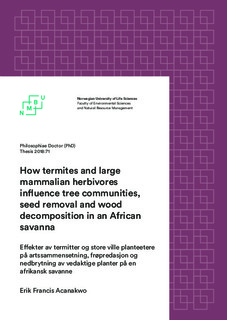| dc.description.abstract | The heterogeneity and extent savannas makes them resilient, diverse and socioeconomically important. Abiotic factors determine large-scale variation on a, but biotic factors matter at small-scales. In the African savannas, termites and ungulates contribute to spatial heterogeneity. Although we know that termites and ungulates influence savanna ecosystems, their combined influence on woody plant communities is uncertain. Despite a near global decline in wild mammalian herbivore population, it remains unclear how woody plant communities respond to such losses. The interactions between termites and ungulates are likely to influence the ecological process of post-dispersal seed removal. Termite activity is also likely to influence wood decomposition, but these effects remain poorly characterized.
The aim of this study was to experimentally investigate the influence of nutrient-rich termite (Macrotermes) mounds and their interactions with ungulate presence and absence on woody vegetation and on seed removal. We also assessed how wood decomposition varied across the landscape, on- and off-mound. We postulated that; a) interactions between termite mounds and ungulates influence woody plant community properties, which would in turn influence seed removal rates; b) the activity of termites determine wood decomposition rates. To discern the effects of termites and ungulates on woody plant community dynamics and seed removal rates, we assessed woody plants on mound and adjacent off-mound plots (with and without ungulates). In addition, we considered the effect of Macrotermes-occupied (active) and non-occupied mounds (inactive) on seed removal. We assessed rates of wood decomposition on five pairs of active-inactive mounds, each with shaded (with canopy cover) and open (without canopy cover) locations, in addition to sample locations off-mound in open level areas between each active-inactive mound pair.
We found that woody stem density and basal area were higher on- than off-mounds and each supported distinct woody vegetation. Species richness and plot level diversity were greater on- than off-mound. Ungulate exclusion had little detectable effect on composition either on or off-mound. However, while ungulate exclusion by fencing resulted in an increase in woody plant species richness and diversity off-mound, there was little effect on-mound. Although seed removal rates were higher on- than off-mound, ungulate exclusion markedly reduced removal rates on-mound, but not off-mound. Seed removal rates were higher on Macrotermes-occupied (active) mounds (30.9% per three days) than unoccupied (inactive) mounds (26.7% per three days). Wood decomposition rates across all selected common species in the landscape proceeded at 1.2 times faster rates on active than inactive mound. Wood decomposition was higher in the shaded than in the open locations. After 12 months, wood mass loss was markedly lower off-mound (12.6 ± 0.8%) than on inactive (19.7 ± 1.2%) and active mound (25.9 ± 1.5%). Mass loss rates reduced with increase in wood density.
These findings indicate that Macrotermes-mound induced habitat heterogeneity is an important determinant of woody plant community dynamics. In addition to the effects of mound, the active Macrotermes themselves influenced rates of seed removal (even though they do not consume them) and wood decomposition rates. Ungulate effects on species richness and diversity measures were stronger in the nutrient-poor off-mound than on-mound sites. Greater stem density and diversity of woody plants on mounds relative to off-mound areas, coupled with their resistance to change in composition with reducing ungulate abundance suggests that mounds support distinct woody plant communities relative to off-mound sites. The increased rates of wood decomposition on mounds point to positive feedback effects for tree regeneration and recruitment. We conclude that the effects of the interaction between ungulates and termites on woody plant community properties and ecosystem processes are context dependent. | nb_NO |

